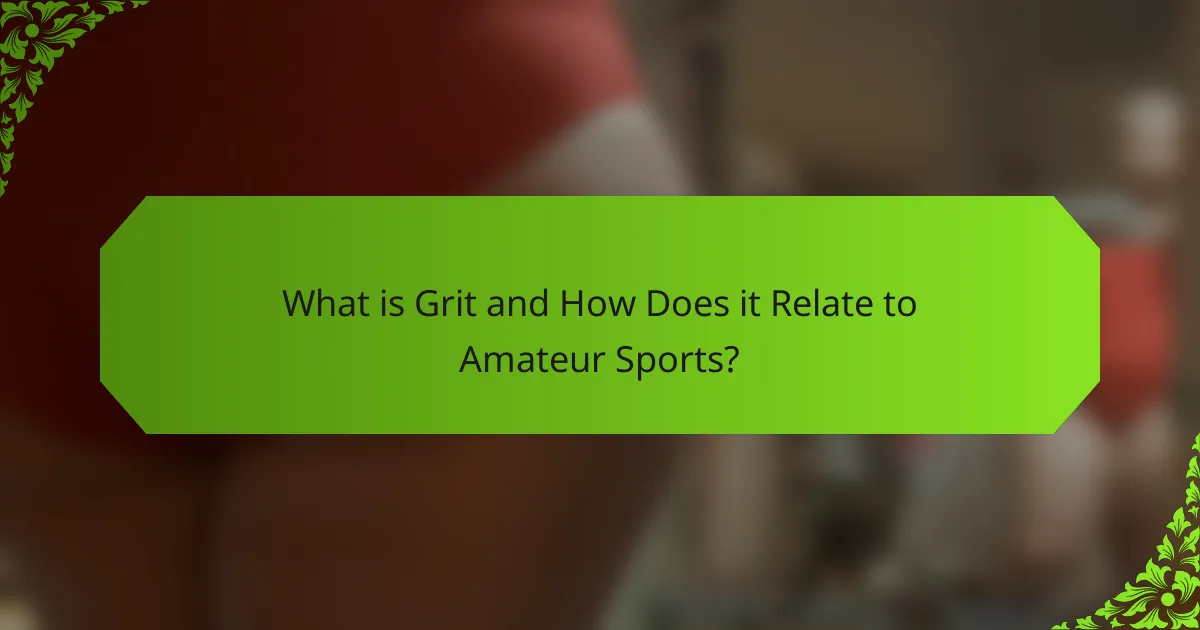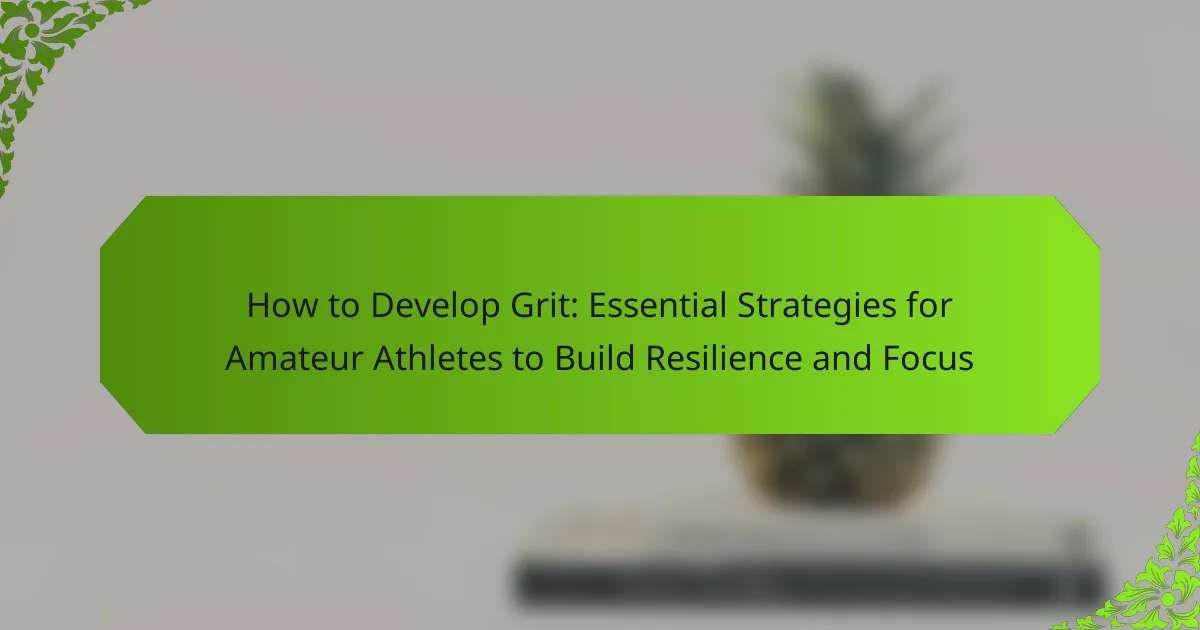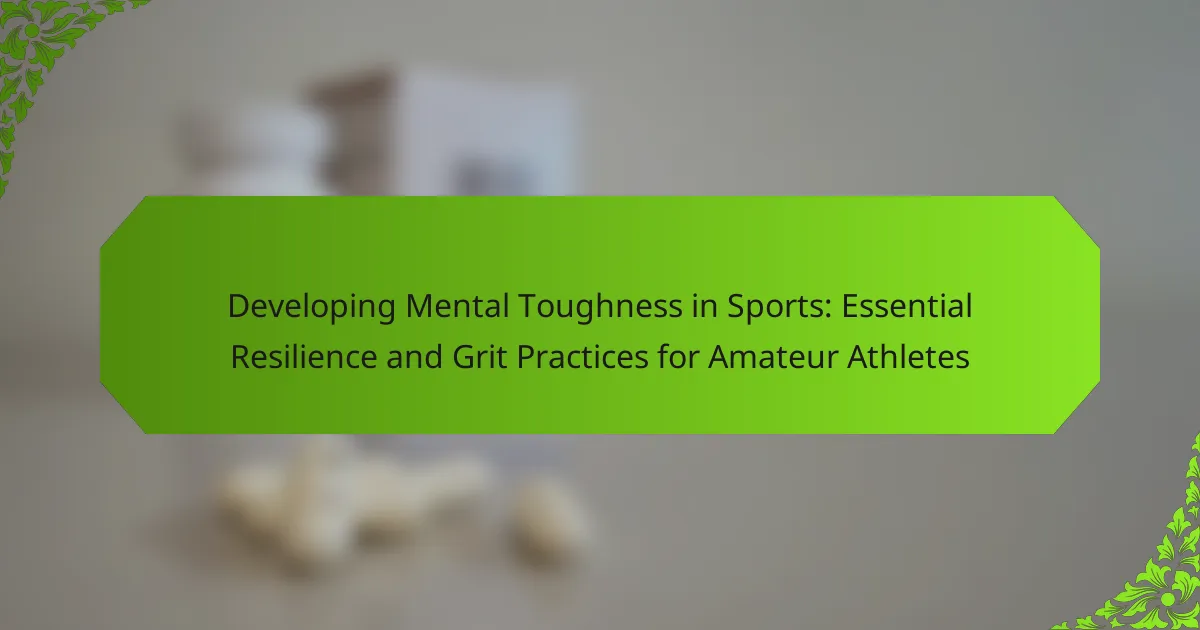Grit and perseverance are essential for success in amateur sports, enabling athletes to overcome challenges and stay focused on long-term goals. This article explores how amateur athletes can cultivate grit through goal setting, visualization, and resilience training. It also discusses strategies for fostering grit in competitive environments, emphasizing the importance of a growth mindset and community support. Developing mental toughness through these practices enhances performance and resilience, crucial for navigating the demands of sports.

What is Grit and How Does it Relate to Amateur Sports?
Grit is a combination of passion and perseverance crucial for success in amateur sports. It enables athletes to face challenges and maintain focus on long-term goals. Research shows that grit is a stronger predictor of achievement than talent alone. Amateur athletes can cultivate grit through consistent practice, setting realistic goals, and embracing setbacks as learning opportunities. Developing mental toughness through grit enhances performance and resilience, making it essential for those pursuing sports at any level.
Why is Mental Toughness Important for Athletes?
Mental toughness is crucial for athletes as it enhances resilience and focus. This quality enables amateur athletes to push through challenges and maintain high performance under pressure. Studies show that athletes with strong mental toughness exhibit better stress management and improved overall performance. Developing grit and perseverance fosters a mindset that embraces challenges, leading to greater success in sports.
How Can Amateur Athletes Develop Grit?
Amateur athletes can develop grit by setting clear goals, embracing challenges, and maintaining a positive mindset. Consistent practice and reflection on experiences foster resilience.
Building mental toughness involves facing adversity, learning from failures, and persisting despite setbacks. Engaging in supportive communities enhances motivation and accountability.
Regularly stepping out of comfort zones strengthens perseverance. Athletes should track progress to recognize growth and celebrate small victories, reinforcing their commitment to long-term objectives.
Incorporating mental training techniques, such as visualization and mindfulness, can further enhance focus and determination, essential attributes for developing grit in sports.
What Techniques Foster Resilience in Training?
Developing resilience in training involves techniques like goal setting, visualization, and positive self-talk. These methods enhance mental toughness and help amateur athletes overcome challenges.
Goal setting provides clear objectives, allowing athletes to track progress and stay motivated. Visualization creates mental images of success, reinforcing confidence and focus. Positive self-talk combats negative thoughts, fostering a resilient mindset.
Incorporating these techniques consistently leads to improved performance and greater perseverance in sports. Engaging in regular reflection on experiences further strengthens resilience, making athletes more adept at handling setbacks.
How Does Goal Setting Enhance Perseverance?
Goal setting enhances perseverance by providing clear objectives and motivation. It helps athletes maintain focus during challenges, fostering mental toughness. Setting specific, measurable goals encourages consistent effort and resilience. Research shows that athletes with defined goals are more likely to overcome obstacles and persist through difficulties, enhancing overall performance.
What Are the Universal Characteristics of Resilient Athletes?
Resilient athletes share universal characteristics such as mental toughness, adaptability, and a strong sense of purpose. These traits enable them to face setbacks and maintain focus on their goals. Mental toughness allows athletes to push through physical and emotional challenges, while adaptability helps them adjust strategies as needed. A strong sense of purpose drives their commitment and determination, fostering perseverance in the face of adversity. These characteristics are essential for amateur athletes striving to enhance their performance and overcome obstacles in their sports journey.
How Do Positive Mindsets Contribute to Grit?
Positive mindsets significantly enhance grit by fostering resilience and determination in athletes. When amateur athletes maintain a positive outlook, they are more likely to persist through challenges, view setbacks as learning opportunities, and cultivate a growth mindset. This psychological framework supports sustained effort and commitment, essential for overcoming obstacles in sports. Research indicates that athletes with positive attitudes demonstrate higher levels of perseverance, which correlates with improved performance and achievement. By embracing positivity, athletes can develop unique attributes of mental toughness, enabling them to push their limits and achieve their goals.
What Role Does Support from Coaches and Peers Play?
Support from coaches and peers significantly enhances grit and perseverance in amateur athletes. Coaches provide guidance, motivation, and accountability, helping athletes overcome challenges. Peers foster a sense of community, encouraging resilience through shared experiences. This support system cultivates mental toughness, essential for achieving long-term goals. Research shows that athletes with strong support networks demonstrate greater perseverance and improved performance.

What Unique Practices Enhance Grit for Amateur Athletes?
Amateur athletes can enhance grit through unique practices such as goal setting, visualization, and resilience training. Goal setting provides clear targets, fostering motivation and focus. Visualization techniques help athletes mentally rehearse success, building confidence. Resilience training encourages overcoming setbacks, reinforcing mental toughness. These practices collectively strengthen perseverance, crucial for navigating challenges in sports.
How Can Visualization Techniques Improve Performance?
Visualization techniques significantly enhance performance by fostering mental resilience and focus. These methods help athletes mentally rehearse their skills, leading to improved execution during competitions. Studies show that visualization can increase confidence, reduce anxiety, and enhance motivation, all critical attributes for amateur athletes facing challenges. By regularly practicing visualization, athletes strengthen their grit and perseverance, ultimately leading to better outcomes in their sports endeavors.
What Steps Are Involved in Effective Visualization?
Effective visualization involves several key steps that enhance mental toughness for amateur athletes. First, set clear goals to define what you want to achieve. Next, gather relevant data to inform your visualization process. Then, create vivid mental images of success, incorporating sensory details to make the experience more immersive. Finally, practice regularly to reinforce these visualizations, which helps build grit and perseverance in overcoming challenges.
What Unique Challenges Do Amateur Athletes Face?
Amateur athletes face unique challenges that hinder their performance and mental resilience. Limited access to resources, such as coaching and facilities, can impact skill development. Balancing training with work or education often leads to time constraints, affecting commitment. Additionally, the pressure to perform without financial support can increase stress, impacting mental toughness. Lastly, the lack of a support network can make it difficult to overcome setbacks, highlighting the importance of grit and perseverance in their journey.
How Can Athletes Overcome Financial and Time Constraints?
Athletes can overcome financial and time constraints by prioritising grit and perseverance. Developing mental toughness helps them navigate challenges effectively.
Creating a budget allows athletes to allocate resources wisely. Seeking sponsorships or grants can provide financial support. Time management skills enable athletes to balance training, work, and personal commitments.
Networking within the sports community opens opportunities for mentorship and collaboration. Emphasising personal discipline fosters a resilient mindset, crucial for facing obstacles.
Engaging in community support programs can also alleviate some financial burdens, offering resources and training facilities.

What Rare Strategies Can Foster Grit in Competitive Environments?
Fostering grit in competitive environments requires unique strategies that emphasize resilience and adaptability. One rare strategy is implementing deliberate practice, where athletes focus on specific weaknesses to enhance their performance. Another approach is cultivating a growth mindset, encouraging athletes to view challenges as opportunities for growth. Incorporating mental imagery techniques can also strengthen mental toughness by helping athletes visualize success and overcome obstacles. Lastly, fostering a supportive community among athletes can enhance motivation and perseverance, creating an environment conducive to grit.
How Can Cross-Training Build Mental Toughness?
Cross-training builds mental toughness by enhancing resilience and adaptability in athletes. Engaging in diverse physical activities challenges the body and mind, fostering grit. This variety helps athletes overcome obstacles and develop perseverance through consistent practice. Research shows that cross-training can improve overall performance and reduce burnout, as it keeps training fresh and engaging. By facing and overcoming different challenges, amateur athletes strengthen their mental fortitude, preparing them for competitive situations.
What Are the Benefits of Adversity Exposure?
Exposure to adversity fosters resilience, enhances problem-solving skills, and builds mental toughness in amateur athletes. These benefits enable athletes to face challenges with confidence and determination.
Resilience is strengthened through experiences that push athletes beyond their comfort zones. Overcoming setbacks teaches them to adapt and persist, which is crucial in competitive sports.
Enhanced problem-solving skills arise as athletes learn to navigate obstacles. They develop strategies to cope with difficult situations, leading to improved performance under pressure.
Building mental toughness is a direct result of facing adversity. Athletes learn to manage stress, maintain focus, and cultivate a positive mindset, all of which contribute to long-term success in sports.
How Does Failing Forward Contribute to Growth?
Failing forward fosters growth by teaching amateur athletes resilience through challenges. This process enhances mental toughness, enabling athletes to learn from mistakes and adapt strategies. As a result, they develop grit, which is crucial for long-term success in sports. Embracing failure transforms setbacks into opportunities, reinforcing the commitment to improvement and perseverance.

What Are the Best Practices for Cultivating Grit in Training?
To cultivate grit in training, focus on setting clear goals, maintaining a growth mindset, and embracing challenges. Consistent practice and self-reflection enhance perseverance.
1. Set specific, measurable goals to track progress.
2. Foster a growth mindset by viewing failures as learning opportunities.
3. Embrace challenges to build resilience.
4. Practice consistently to develop habits that reinforce grit.
5. Reflect on experiences to identify areas for improvement.
6. Seek support from coaches and peers to stay motivated.
How Can Athletes Create a Resilient Training Environment?
Athletes can create a resilient training environment by fostering a culture of grit and perseverance. This involves setting clear goals, encouraging open communication, and promoting a growth mindset.
Establishing a supportive community helps athletes share challenges and strategies. Regular feedback enhances motivation and accountability, reinforcing mental toughness. Incorporating mental training techniques, such as visualization and mindfulness, further strengthens resilience.
Athletes should also embrace adversity as a learning opportunity. Reflecting on setbacks cultivates perseverance, essential for overcoming challenges. This approach not only builds mental toughness but also enhances overall performance.
What Common Mistakes Should Amateur Athletes Avoid?
Amateur athletes should avoid common mistakes that hinder their grit and perseverance. Key errors include neglecting proper training, underestimating recovery, failing to set realistic goals, and lacking mental preparation.
1. Neglecting proper training: Skipping structured workouts leads to inadequate skill development.
2. Underestimating recovery: Ignoring rest can result in burnout and injuries.
3. Failing to set realistic goals: Setting unattainable objectives can diminish motivation.
4. Lacking mental preparation: Not developing mental toughness can impair performance under pressure.
By recognizing and addressing these mistakes, amateur athletes can enhance their resilience and ability to overcome challenges.
What Expert Insights Can Help in Building Mental Toughness?
Expert insights suggest that building mental toughness involves cultivating grit and perseverance through consistent practice and self-reflection. Key strategies include setting specific goals, embracing challenges, and maintaining a positive mindset. Research indicates that athletes who adopt a growth mindset are more likely to overcome obstacles and persist in their training. Additionally, developing coping mechanisms for stress and failure can enhance resilience, enabling amateur athletes to navigate setbacks effectively. Engaging in regular mental conditioning exercises, such as visualization and mindfulness, further strengthens mental fortitude.



